JMP Live Help
Create visualizations with your data in JMP and share your analyses using JMP Live. Anyone viewing these posts has the interactive capabilities of JMP to explore your data.
Find out more about these topics:
Publish JMP Graphs and Reports as Posts
You can use JMP 15 to publish graphs and reports to JMP Live. Graphs and reports appear in a JMP Live post. Create your graphs and reports in JMP and then click File > Publish. For more details, see Save and Share Reports.
Figure 1.1 JMP Live Post Thumbnails
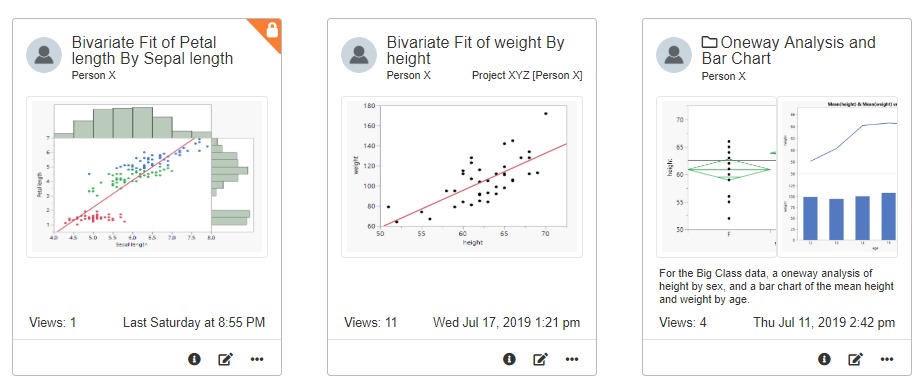
Note: If you choose to make your posts private (shared with Only Me), an orange lock icon appears on the post in JMP Live.
Figure 1.2 Example of a JMP Live Post
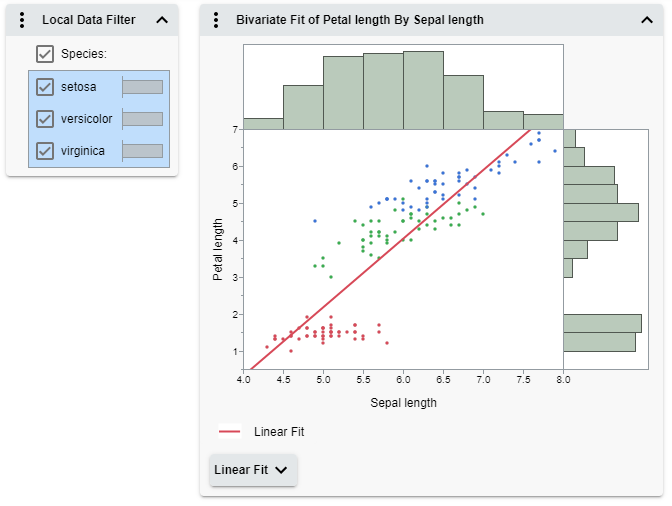
Interact with Posts
Find out what you can do in posts:
Open Posts
Posts appear under My Dashboard and All Posts:
|
•
|
My Dashboard: Contains all of the following types of posts:
|
|
–
|
posts that you have published
|
|
–
|
posts that your followers have published
|
|
–
|
posts published to groups that you are a member of
|
|
•
|
All Posts: Contains everything from My Dashboard and all public posts (that are shared with everyone).
|
Click a post to open it. If there is only one post, it opens directly. If there are several posts, click the one you want to see.
Figure 1.3 Single Post Thumbnail (Left) and Multiple Post Thumbnail (Right)
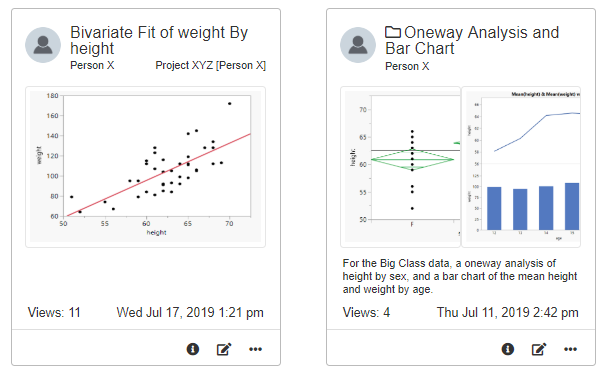
In a graph or a report, point your cursor or tap on a data point or a calculation to see its values or description.
Note: To open or close reports and graphs, click or tap the arrow to the right of the title.
Figure 1.4 See a Data Point’s Values
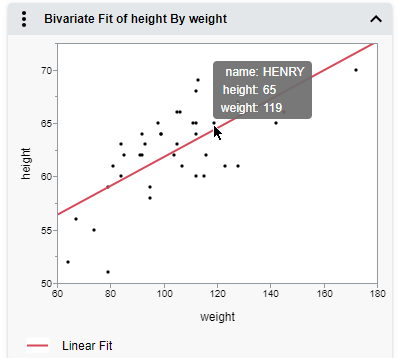
Figure 1.5 See an Explanation of a P-Value Calculation

Select Data
How you select data in a graph (points, bars, and so on) depends on whether you are on a computer or a mobile device. The default mode is to select a single data point. If you want to select multiple data points:
|
•
|
On a computer, press Shift then select the data points.
|
|
•
|
On a mobile device, tap the multiple selection icon and then select the data points.
|
|
On a computer
|
On a mobile device
|
|
|---|---|---|
|
Select or deselect a single data point
|
Click a data point.
|
Tap
 then tap a data point. then tap a data point. |
|
Select or deselect multiple data points
|
Hold down the Shift key and click multiple data points.
|
Tap
 then tap multiple data points. then tap multiple data points. |
|
Identify a single data point
|
Point to a single data point.
|
Tap
 then tap a data point. then tap a data point. |
|
Select data points by brushing
|
Click and drag a rectangle over data points. Click and drag in the center to move the rectangle, or drag the corners to resize it.
|
Tap
 then draw a rectangle over the data points. Drag the center to move the rectangle, or drag the corners to resize it. then draw a rectangle over the data points. Drag the center to move the rectangle, or drag the corners to resize it. |
See Linked Data
If your JMP report contains multiple graphs, data in all graphs are linked. So if you select data, it is highlighted in all associated graphs.
Figure 1.6 Select Data in Linked Graphs
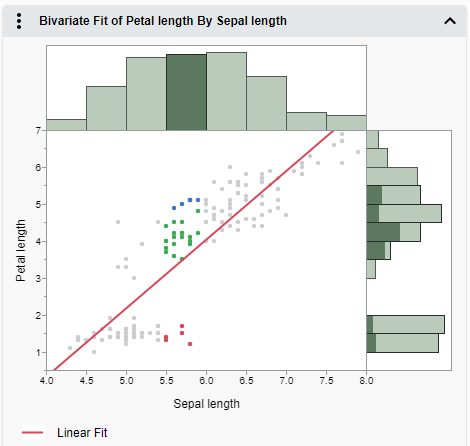
In this example, a histogram bar in the top graph is selected. The corresponding rows are highlighted in the scatterplot and in the marginal histogram.
Exclude and Hide Data
Once you have selected data, you can exclude it from report calculations and hide it in graphs. Reports and graphs automatically update.
Figure 1.7 Report Menu Options
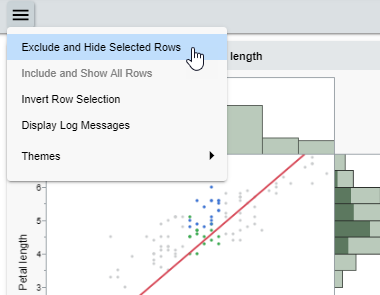
To exclude and hide data, use the options in the Report menu:
Note: If the report contains a Local Data Filter, most of these options do not appear, since you use the Local Data Filter instead.
|
•
|
Exclude and Hide Selected Rows: Excludes and hides selected data.
|
|
•
|
Include and Show All Rows: Includes and shows any excluded or hidden data.
|
|
•
|
Invert Row Selection: Changes the current selection to the deselected data.
|
The Report menu also contains these options:
|
•
|
Display Log Messages: Shows messages from the server and any unexpected conditions from the client.
|
|
•
|
Themes: Changes the page appearance. See Change the Theme.
|
Filter Data
If the original JMP report included a Local Data Filter, you can use it to focus on specific data and see the impact on graphs and reports.
Figure 1.8 Filter Data in Graphs
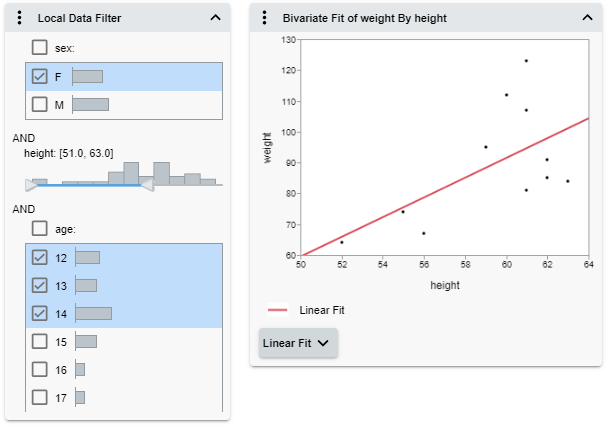
In this example, the filter choices are showing only females between 51 and 63 inches tall who are between the ages of 12 and 14.
Local Data Filter Options
Conditional Filtering
Limits the options in the Local Data Filter by condition. For more information, see Using JMP.
Note: This option does not appear if there is more than one OR group, or if the columns are not hierarchical.
Invert filter
Inverts currently selected filters.
Select filtered rows in graphs
Selects all filtered rows in graphs.
Show filtered rows in graphs
Shows all filtered rows in graphs.
Include filtered rows in calculations
Only filtered rows are included in report calculations.
Modify Graphs
Use the options in the  menu to customize graph elements.
menu to customize graph elements.
 menu to customize graph elements.
menu to customize graph elements.
Figure 1.9 Change the Marker Size
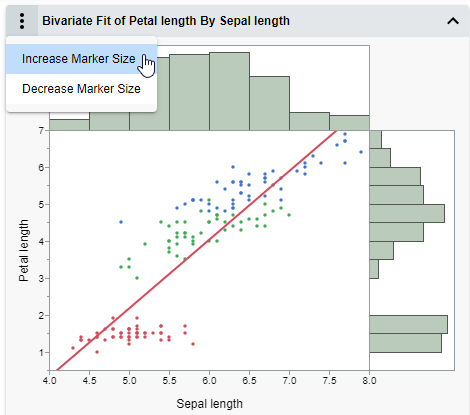
The options in this menu can vary depending on the type of graph or JMP platform. For example:
|
•
|
In scatterplots and histograms, you can change the marker size.
|
|
•
|
In profilers, you can reset the profiler to its original state, or re-scale the vertical axis to include the response.
|
|
•
|
In data filters, you can choose how you want to filter data.
|
|
•
|
In bubble plots, you can change the appearance of the bubbles.
|
Change the Theme
To change the page appearance, click  > Themes.
> Themes.
 > Themes.
> Themes.
Figure 1.10 Change the Page Theme

Edit Posts or See Post Details
On a post thumbnail, or from a post, you can do the following:
|
•
|
Click
|
|
•
|
Click
|
Figure 1.11 Edit a Post’s Details
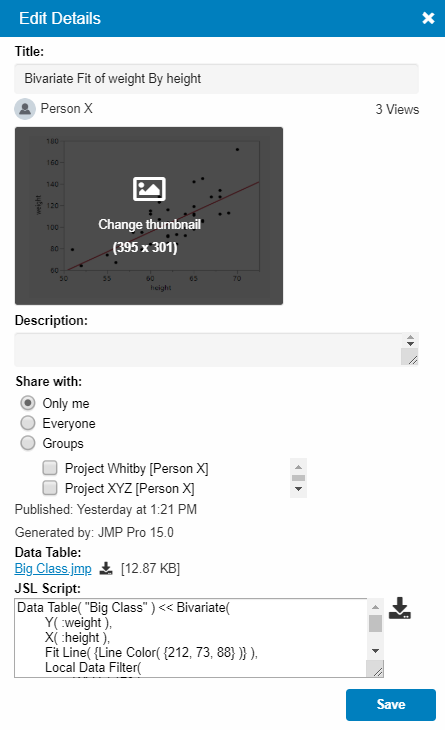
You can download the associated data table(s) and the JSL script that re-creates the post.
Tip: If you want to add a link to a website in the report description, you can use these HTML tags: <a href= "target">, <b>, <em>, <i>, <strong>, and <u>.
Delete Posts
On a post thumbnail or from a post, click  > Delete to delete a post that you created.
> Delete to delete a post that you created.
Figure 1.12 Delete a Post
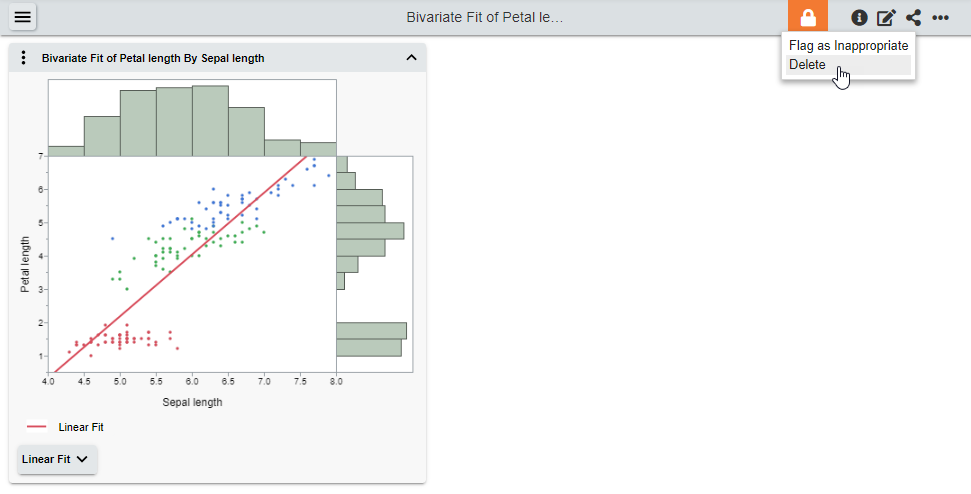
Share Posts
From a post, click  to share the post. You can share a post in any of these ways:
to share the post. You can share a post in any of these ways:
|
•
|
on social media: Facebook, Twitter, LinkedIn
|
Note: These options do not appear if your administrator has disabled them.
|
•
|
email a link
|
|
•
|
copy a link
|
|
•
|
copy embedded HTML code (for a web page)
|
Figure 1.13 Sharing Options
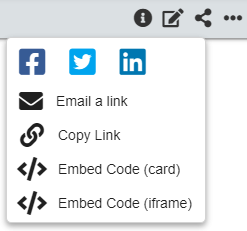
Note: If you are sharing your own post, you might not see all of these options if the sharing setting is restricted to only you. To change sharing settings, click  and share with everyone or with a group.
and share with everyone or with a group.
Flag Posts or Users
If you think a post or user profile contains inappropriate content, you can flag it to the administrator:
|
•
|
To flag a post: On a post thumbnail or from a post, click
|
|
•
|
To flag a user profile: From a user profile, click
 > Report User. > Report User. |
Here is what happens when a post or user profile is flagged:
|
1.
|
JMP Live administrators determine whether the post or user profile should be hidden or removed.
|
|
2.
|
If the post is hidden or removed, the owner of the flagged post or the flagged user is notified (if they have not turned off notifications for flags). For hidden posts, the owner can attempt to fix the problem and let the administrator know. The administrator can then reinstate the post if they approve.
|
Manage Notifications
Note: This section covers user notifications. For administrator notifications, see Manage Admin Notifications.
In JMP Live, you are notified when any of these things happen:
|
•
|
someone new starts following you
|
|
•
|
someone requests to join a closed group that you are an administrator of
|
|
•
|
someone flags a post that you created or flags your user profile
|
|
•
|
an administrator deletes one of your posts
|
To see your notifications, click Notifications  . From here, you can do the following actions:
. From here, you can do the following actions:
|
•
|
Click a notification to take you to its source. For example, if someone started following you, their user profile opens. If you receive a request to join a closed group, the group opens.
|
|
•
|
Click See All to see all notifications in a larger window. From here, you can do the following:
|
|
–
|
Click Mark All as Read to turn them from gray (not read) to white (read) and remove the notification number flag.
|
|
–
|
Click Clear All to clear all notifications.
|
|
–
|
Click
|
|
–
|
Click Settings to manage your notifications. See Manage Notification Settings.
|
Manage Notification Settings
On the Notification Settings page, you can choose which types of notifications you want to receive and how often you want to get email notifications.
|
•
|
Stop receiving a notification of a certain type: Under On JMP Live, click Off.
|
|
•
|
Change how often you get email notifications: Under Email, choose a time period.
|
Figure 1.14 JMP Live Notification Settings
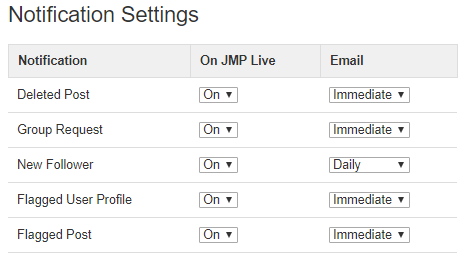
Search for People, Posts, or Groups
You can search JMP Live in these ways:
|
•
|
To search all of JMP Live, enter a name or keyword in the search box at top right.
|
|
•
|
To filter posts on the Home pages, enter text in the Find User, Find Group, and Find (keywords in posts) boxes. See Filter Your Search.
|
Figure 1.15 Search Options (JMP Live and JMP Public)

Filter Your Search
To use filters, depending on where you want to search, go to Home > My Dashboard or All Posts.
|
•
|
To find all posts from a user or group, enter a user name or group name in the Find User or Find Group box. Suggestions appear as you type.
|
|
•
|
To search by a keyword in a post title, enter a word into the Find box.
|
|
•
|
You can refine your search by restricting the date or by limiting it to a certain group.
|
|
•
|
To clear your search, click the x next to a user name, or clear other fields by clicking Clear All.
|
Follow Someone
If you follow someone, their posts appear on your Dashboard.
Figure 1.16 Follow Someone
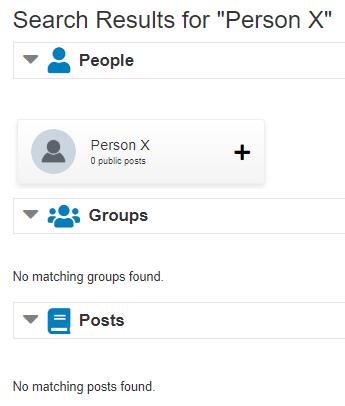
To follow someone, do one of these actions:
|
•
|
Next to their name in the search results, click
|
|
•
|
Click a person’s name to go to their user profile, and then click Follow.
|
Edit Your Profile
|
1.
|
At the top right, click your name > My Profile.
|
|
2.
|
Click Edit.
|
|
3.
|
Change your picture, display name, or password.
|
|
4.
|
Click Save.
|
JMP Live Groups
There are different types of groups in JMP Live:
|
•
|
Personal groups: Users and administrators can create personal groups. Only people that you add to a personal group can see the group and its posts. Personal groups can be owned by the creator of the group, or by a member that you specify as an administrator of the group.
|
|
•
|
Open, Closed, or Hidden groups: Only administrators can create these types of groups.
|
|
–
|
Open: Anyone can find the group, join the group, and see the posts and members.
|
|
–
|
Closed: Anyone can find the group, but only members can see the posts and members. People can request to join the group.
|
|
–
|
Hidden: Only members can find the group and see posts and members.
|
On the Groups page, you see My Groups or All Groups:
|
•
|
My Groups: Shows all groups that you are a member of.
|
|
•
|
All Groups: Shows all groups that you are a member of and all open and closed groups that you can join or ask to join.
|
Figure 1.17 My Groups Page
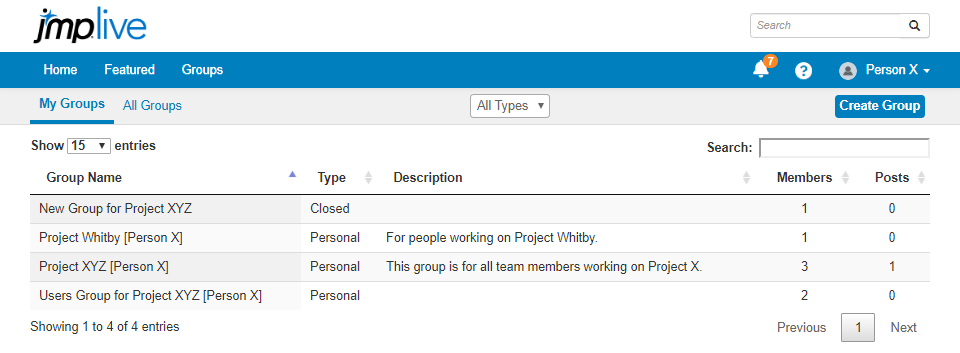
When you add someone to a group, they are added automatically. They can choose to leave the group.
Create JMP Live Groups
|
1.
|
Click Groups.
|
|
2.
|
Click Create Group.
|
Figure 1.18 Create New User Group

|
3.
|
Name the group.
|
|
4.
|
(Optional) Add a group description.
|
|
5.
|
Click Find user and type user names to add members.
|
Clickable suggestions appear as you type.
|
6.
|
As an administrator, you can choose the group type:
|
|
–
|
Open: Anyone can find the group, ask to join the group, see who is in it, and what they post.
|
|
–
|
Closed: Anyone can find the group, but only members can see posts and who is in the group. People can request to join the group.
|
|
–
|
Hidden: Only members can find the group, see posts, and who is in the group. Owned by the administrator who is creating the group.
|
|
–
|
Personal: Only members can find the group, see posts, and who is in the group. Owned by a member that you specify.
|
|
7.
|
Click Create.
|
Share JMP Live Posts with Groups
When you publish a report from JMP, you can share it with a group. For details, see Using JMP. Or, you can share a published post with a group from JMP Live.
|
1.
|
Click Home > My Dashboard to see your posts.
|
|
2.
|
Open the post that you want to share.
|
|
3.
|
Click Edit
|
|
4.
|
In the Share with section, click Groups > group name.
|
|
5.
|
Click Save.
|
The post appears on the group page and on the group members’ Home pages.
|
6.
|
To stop sharing a post with a group, do one of the following:
|
|
–
|
Click Edit
|
|
–
|
Click
|
Add Members
|
1.
|
Click Groups > My Groups.
|
|
2.
|
Click the name of the group that you want to add members to.
|
|
3.
|
Click
 > Add Members. > Add Members. |
|
4.
|
Type user names to add members.
|
Clickable suggestions appear as you type.
|
5.
|
Click Submit.
|
Remove Members
|
1.
|
Click Groups > My Groups.
|
|
2.
|
Click the name of the group that you want to remove members from.
|
|
3.
|
Click Manage Group.
|
|
4.
|
Click the row (not the Display Name) containing the names of the members that you want to remove.
|
|
5.
|
Click Delete
|
Change Member Permissions
|
1.
|
Click Groups > My Groups.
|
|
2.
|
Click the name of the group that contains the members whose permissions you want to change.
|
|
3.
|
Click Manage Group.
|
|
4.
|
Click Edit Permissions.
|
|
5.
|
Select the check boxes to set these permissions:
|
|
–
|
Can Publish: Member can publish posts to the group.
|
|
–
|
Can Remove Posts: Member can remove posts from the group. Removing a post makes it This visible to only its original owner.
|
|
–
|
Group Admin: Member is a group administrator. Administrators can add or remove members from the group, change member permissions, and delete posts from the group.
|
|
6.
|
Click Save.
|
Manage Join Requests
People can request to join closed groups. You can approve or deny requests.
|
1.
|
Click Groups > My Groups.
|
|
2.
|
Click the name of the group that you want to manage requests for.
|
|
3.
|
Click Manage Group > Requests.
|
|
4.
|
Click Approve or Deny next to the member’s name.
|
Edit Groups
|
1.
|
Click Groups > My Groups.
|
|
2.
|
Click the name of the group that you want to edit.
|
|
3.
|
Click
 > Edit Group. > Edit Group. |
|
4.
|
Update the group details.
|
|
5.
|
Click Save.
|
Delete Groups
|
1.
|
At the top of the JMP Live web page, click Groups.
|
A list of any groups that you are a member of appears in My Groups.
|
2.
|
Click the group name.
|
|
3.
|
Click
 > Delete Group. > Delete Group. |
|
4.
|
Click OK.
|
Administrator Options
From the Admin menu in JMP Live, you can do the following:
Manage Admin Notifications
As an administrator, you are notified in situations like these:
|
•
|
when someone flags a post or user profile as inappropriate
|
|
•
|
when someone updates a flagged post or user profile
|
|
•
|
when someone requests to join a group that has no group administrator
|
If you have notifications, a number appears next to the Admin menu.
To see notifications, click Admin > Notifications. You can do these actions:
|
•
|
Click a notification to take action on it or see details. See Manage Flagged Content.
|
|
•
|
Next to a notification, click
|
Manage Users
To see and manage all JMP Live users, click Admin > Users.
For each user, you can change these aspects:
|
•
|
the user’s display name
|
|
•
|
whether the user can access JMP Live (is enabled)
|
|
•
|
whether the user can publish content to JMP Live
|
Manage Groups
To see and manage all JMP Live groups, click Admin > Groups.
You can see the group name, type of group, a description of the group, the number of members, and the number of posts.
Click a group name to add or remove members, change member permissions, review requests to join the group, edit the group, or delete the group. For details, see JMP Live Groups.
Manage Flagged Content
To manage posts or user profiles that are flagged as inappropriate, click Admin > Flagged Content.
You can do any of these actions:
|
•
|
Clear the flags if the content or user profile is deemed appropriate.
|
|
•
|
Hide the content or user profile for now. You can approve the content or user profile if it is updated or deemed appropriate, or you can delete it.
|
|
•
|
Delete the content completely from JMP Live.
|
Manage Settings
As an administrator, you can change run-time settings and view configuration settings. Configuration settings are read-only, but can be changed in the environment (.env) files, normally located here:
C:\Program Files\SAS\JMP Live\JMPLive
C:\Program Files\SAS\JMP Live\JMPPool
Update the environment files to specify any settings that you want to change the default value for. The environment files contain only exceptions to the default settings.
Runtime Settings
Allows Anonymous Access
Choose whether anonymous users (persons not logged in to JMP Live) can access JMP Live (on), or if a logon is required (off). If this option is turned on, when someone sends a link to a JMP Live post that is shared with everyone, anonymous users can see the post on JMP Live.
Admin Email Address
Enter an email address for the JMP Live administrator.
Admin Email Address No Reply
Enter an email address from which to send automatic replies coming from JMP Live. Replies to this address are not monitored.
Publish Throttle Count
Set how many times a user is allowed to publish posts to JMP Live within the value specified in Publish Throttle Minutes. A value of zero means that there is no limit.
Publish Throttle Minutes
Set the number of minutes within which a user is allowed to publish, at most, the number of posts specified in the Publish Throttle Count. A value of zero means that there is no limit.
Replace Throttle Count
Set how many times a user is allowed to replace posts to JMP Live within the value specified in Replace Throttle Minutes. A value of zero means that there is no limit. If you specify a negative value, the Publish Throttle Count value is used.
Replace Throttle Minutes
Set the number of minutes within which a user is allowed to replace, at most, the number of posts specified in the Replace Throttle Count. A value of zero means that there is no limit. If you specify a negative value, the Publish Throttle Minutes value is used.
User Storage Limit MB
Set the per-user limit on storage in MB. A value of zero means that there is no limit.
Maximum Package Size MB
Set the maximum size of an individual post in MB. This includes all uploaded assets, such as HTML files, thumbnail images, and data tables.
Maximum Avatar Size KB
Set the maximum size in KB of a user’s profile picture.
SMTP Server Address
(Required for sharing by email.) Set the name of the SMTP server to use for sending email.
SMTP Port
(Required for sharing by email.) Set the port number to use for connecting to the SMTP server.
SMTP User
(Required for sharing by email.) Set the user name for connecting to the SMTP server.
SMTP Password
(Required for sharing by email.) Set the password for connecting to the SMTP server.
SMTP Ignore TLS
Choose whether the SMTP connection should ignore Transport Layer Security (TLS) (on) or not ignore TLS (off).
View Expire Seconds
Set the number of seconds that must elapse before a user’s view of a post counts as an additional view of the post.
Prevent Index Page Caching
Choose whether cache-control headers are passed with a post’s index file, which prevents a browser from caching the headers (on) or not passed (off).
Loggly Token
Set the token to use when sending log records to Loggly. Loggly is a website log indexing service that helps you make sense of your web logs.
Loggly Sub-domain
Set the Loggly sub-domain to send log records to. For a description of Loggly, see Loggly Token.
Automatic HTML Regeneration
Choose whether HTML generated by older JMP versions is automatically regenerated in the background (on) or not (off). If this setting is on, existing HTML posts are queued for regeneration, and newly published posts and posts visited by users are regenerated immediately.
Auto-Regen Max Age Days
If Automatic HTML Regeneration is turned on, set the age of reports (in days) to add to the regeneration queue. If set to zero, no more reports are added to the queue, but any existing reports in the queue are regenerated.
Regeneration Frequency (seconds)
(Applicable only if Automatic HTML Regeneration is set to on.) Set the number of seconds to wait between automatic HTML regenerations.
Max Active Regenerations
(Applicable only if Automatic HTML Regeneration is set to on.) Set the maximum number of HTML regenerations that can take place at one time. The range is from 1 to 8.
Configuration Settings
JMP Release
Set the major release version of JMP that is allowed to publish content to JMP Live. The JMP version must be less than or equal to the version of JMP Live.
Authentication Scheme
Set the authentication scheme that JMP Live uses. Possible values include: sasprofile, ldap, and local. This should be set once and never changed unless starting over with an empty database.
JMP Live Launch Time
Shows the time at which this instance of JMP Live was initially launched.
Allow social sharing
Choose whether to allow users to share posts on social media (Facebook, LinkedIn, and Twitter).
Cookie Expire Time
Set the amount of time a session’s cookie is valid. You cannot enter below 5 seconds.
SSL .crt File
Set the path to the .crt file. A .crt file is a digital certificate file that is used with a web browser to verify a secure website’s authenticity.
SSL Key File
Set the path to the certificate key file. A certificate key file is a private text file used initially to generate a Certificate Signing Request. It is used later to secure and verify connections using the certificate that was created by that request.
SSL Certificate Authority File
Set the path to the certificate authority file. This file contains the public key signatures of the chain of signing authorities that have signed the SSL certificates.
Default Loggly Token
Set the default token to use when sending log records to Loggly. For a description of Loggly, see Loggly Token.
Monitor the Status of JMP Pools
A JMP pool has a number of JMP sessions running on different ports. You can monitor the status of JMP pools under Admin > JMP Pool Status. Click the gray arrow beside the web address to see the JMP sessions for that pool.
Figure 1.19 JMP Pool Status
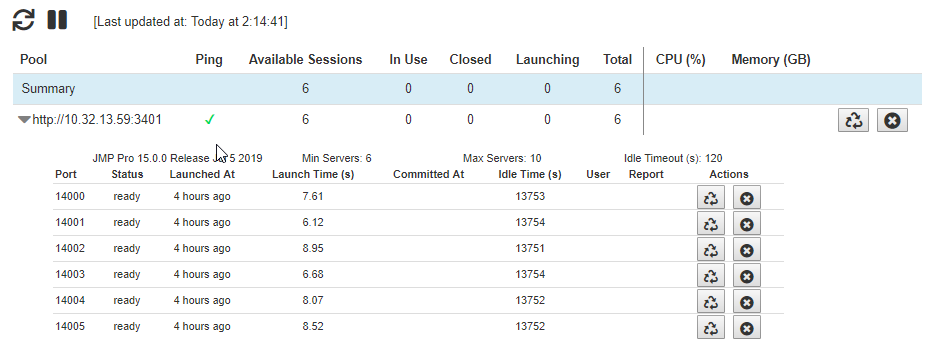
The Summary at top shows you how many JMP sessions are available, in use, closed, or launching, and how many JMP sessions you have in total. You also see CPU and memory statistics indicating how busy the sessions are.
If a session is in use, you can see who is using it, when it was launched, and the JMP report associated with the JMP session.
The window refreshes automatically every 5 seconds. You can do any of the following actions:
|
•
|
Click Refresh
|
|
•
|
Click Pause
|
|
•
|
Click Play
|
Restart a Session
If a session in a pool appears to be hanging, you have two options:
|
•
|
First, click Recycle
|
|
•
|
If Recycle does not work, click Terminate
|
To restart all sessions in a pool, click Recycle or Terminate next to the pool’s web address.
Manage the Audit Log
The audit log tracks changes users make in JMP Live, such as publishing a post, deleting a post, creating a user, following someone, and so on. It is a record that administrators can use to see user activity and troubleshoot issues. Click Admin > Audit Log to open the audit log.
Search the Audit Log
You can search the audit log by a specific action, user, post, or IP address. Limit your search using any combination of these filters:
|
•
|
Search by action: Search by a specific action, such as a deleted post, shared post, and many more:
|
|
1.
|
Click All actions.
|
|
2.
|
Check the box of the action that you want to search for. See Action Types.
|
|
3.
|
Click Apply.
|
|
4.
|
To remove all actions, click Clear and then click Apply.
|
|
•
|
Search by user: Enter a person’s display name into the Find User box.
|
|
•
|
Search by post: Enter the post ID in the Find Object box. The post ID appears at the end of the URL of a JMP Live post.
|
|
•
|
Search by IP address: Enter an IP address into the Find IP address box.
|
|
•
|
Limit the date range: Click All dates and choose a date, or click Custom Dates to enter a specific date range.
|
In the search results, you can see the following:
|
•
|
whether the action succeeded or failed
|
|
•
|
who performed the action
|
|
•
|
when the action was done
|
|
•
|
details about the action (in JSON format)
|
|
•
|
the IP address of the user who performed the action
|
Click the x beside a user name or post ID filter to remove it from the search.
Figure 1.20 Remove Filter
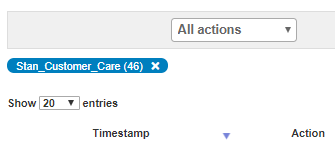
Action Types
The following table describes the options in the All actions menu.
|
Prefix
|
Action
|
Description
|
|---|---|---|
|
group
|
create
|
A new group was created.
|
|
delete
|
A group was deleted.
|
|
|
pkg-remove
|
A post was removed from a group.
|
|
|
update
|
A group was updated.
|
|
|
jmp
|
allocate
|
A user performed an action (such as using a data filter) that caused JMP Live to initiate a JMP session.
|
|
setpackage
|
A user performed an action (such as using a data filter) that caused JMP Live to initiate a JMP session and to assign a post to the session.
|
|
|
terminate
|
A JMP session was terminated.
|
|
|
mod
|
approved
|
An administrator approved a post or a user.
|
|
denied
|
An administrator determined that a flagged post or user profile should not be visible to anyone other than the publisher due to inappropriate content.
|
|
|
pending
|
The owner of flagged content (a post or a user profile) has modified it to try to make it no longer inappropriate. The content is waiting for an administrator to determine whether the content is now acceptable.
|
|
|
quarantined
|
An administrator has determined that flagged content (a post or a user profile) is inappropriate and should be prevented from being seen by anyone (including the publisher or user in question).
|
|
|
pkg
|
publish
|
A post was published.
|
|
replace
|
A post was replaced.
|
|
|
update
|
A post was updated.
|
|
|
delete
|
A post was deleted.
|
|
|
refresh
|
A data filter or the excluded rows in a post was changed, causing the report to be recalculated using a JMP session.
|
|
|
permissions
|
Permissions on a post were changed.
|
|
|
share-email
|
A post was shared using email.
|
|
|
share-social
|
A post was shared on social media.
|
|
|
flag
|
A post was flagged.
|
|
|
regenerate
|
A post was re-generated using JMP. This happens when a post is originally generated by an earlier version of JMP than what JMP Live is using.
|
|
|
download
|
A post was downloaded.
|
|
|
flag-delete
|
A flag on a post was removed because an administrator marked the post approved.
|
|
|
move
|
A post was moved into a folder or out of a folder or from one folder to another.
|
|
|
augment
|
A newly published post was added to an existing folder rather than being published as stand-alone or in its own folder.
|
|
|
user
|
allow-publish
|
A user was given permission to publish JMP reports to JMP Live.
|
|
avatar-change
|
A user changed their profile picture.
|
|
|
create
|
A new user was created.
|
|
|
delete
|
A user was deleted.
|
|
|
deny-publish
|
A user’s status was set to disallow publishing on JMP Live.
|
|
|
disable
|
A user was disabled from JMP Live. If they log on, they get a message that their access to JMP Live is denied.
|
|
|
enable
|
A user’s status was changed from disabled to enabled. They can log in and see posts on JMP Live and might be able to publish posts.
|
|
|
flag
|
A user’s profile was flagged as inappropriate.
|
|
|
follow
|
A user was followed on JMP Live.
|
|
|
remove-admin
|
A user’s JMP Live administrative status was removed.
|
|
|
set-admin
|
A user was made a JMP Live administrator.
|
|
|
unfollow
|
A user was unfollowed.
|
|
|
unfollow-all
|
A user has stopped following everyone that they used to follow.
|
|
|
update
|
A user’s profile was updated.
|
|
|
server
|
settings-change
|
The server settings were updated.
|
Regenerate a Post
If a report looks incorrect in JMP Live, you can re-generate the report from JMP and reload the post. From a post, click Admin > Regenerate.
A post is also regenerated automatically if a user visits a report that was generated by a version of JMP that is older than the version of JMP that JMP Live is using.